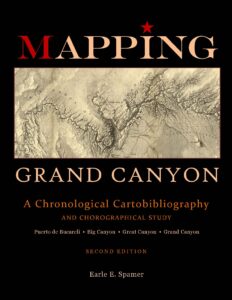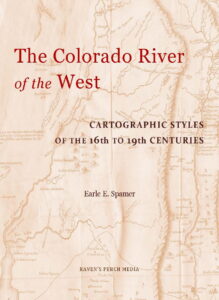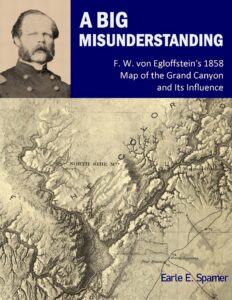
Cartobibliography of the Grand Canyon and Lower Colorado River Regions in the United States and Mexico: A Chorographical Study, 16th to 21st Centuries
3rd EDITION — Greatly revised and expanded (2025)
SPECIAL NOTE: In Sections 4A and 4B of the Cartobibliography, some illustrations embedded in the PDFs that depict the system of topographic map quadrangles (which had been replicated from old-style paper copies) do not sufficiently display the quadrangle names when the PDFs are enlarged. Click on the buttons below to download high-resolution JPEG images of these maps.
THE CARTOBIBLIOGRAPHY is Volume 2 of The Grand Canon : A Worldwide Bibliography of the Grand Canyon and Lower Colorado River Regions in the United States and Mexico. It itemizes and often describes details on maps produced worldwide from the 16th to 21st centuries. Many citations for historical maps before the 20th century are chorographical; attention is on part of the map rather than the whole, in order to describe how the Grand Canyon and lower Colorado River regions are portrayed. Thus the principal purpose of the map may not be mentioned, such as when a map is of wider interest to cartographic histo-rians for content that is unrelated to the physical geography of the Southwest. In some instances, remarks correct or amplify the work of earlier bibliographers. All forms of maps are listed: general, geologic and physiographic, and certain specialized maps; to which is added a complete guide to all scales of topographic map quadrangles in the greater Grand Canyon–lower Colorado River regions in the U.S. and Mexico, produced by the U.S. Geological Survey and Mexico’s Instituto Nacional de Estadística y Geografía (as also used by the Servicio Geológico Mexicano). The kinds of maps cited here vary. Many are stand-alone productions, while others are included in atlases or accompany reports of explora-tions, some of them as large fold-outs, others as maps loosely laid in or even grouped in separate covers. Maps that appear as illustrations within books and periodicals are not generally considered. Neither are manuscript maps considered, although a few significant ones are cited; those that are of primary importance in the history of the Grand Canyon and the Southwest. Notes added to these citations provide more detailed information that describe relationships between features of physical geography, for the benefit of users who may thus determine that a map should be more closely examined, or it may suggest to them that a map is not of interest to work at hand. The Cartobibliography divides maps into two major groups (arranged alphabetically by cartographer or creator): 16th–18th cen-turies, and 19th–21st centuries; and there is a separate, consolidated chronological list of these maps. The 16th to 18th centuries in this region recorded human interactions that focused on the lower Colorado River, by international parties with interests in the region. Only manuscript maps ventured to embrace the area that now is known to be the Grand Canyon. The 19th century saw the first sponsored explorers in three centuries spanning the region, eventually delineating the Colorado River and its tributaries correctly, again reporting the Grand Canyon. And the 20th century witnessed an explosion of general and scientific maps of the region, including topographic mapping at large scales. More specifically detailed bibliographical products and statistical surveys can be derived from this Cartobibliography.
ALSO AVAILABLE

Mapping Grand Canyon: A Chronological Cartobibliography and Chorographical Study. 2nd Edition (2025)
Mapping Grand Canyon is divided into four major sections. Each concentrates on one of the principal names by which Grand Canyon was called during the past three centuries, which have appeared on maps though of course not necessarily with any degree of formality or consistency: Puerto de Bucareli (1777-1884); Big Canyon (1853-1910); Great Canyon (1853-1879); Grand Canyon (1868-present).
The citations are extracted from Cartobibliography of the Grand Canyon and Lower Colorado River Regions in the United States and Mexico (5th Edition, 2025, Volume 2 of THE GRAND CANON series). It offers up a historiographical listing specifically for the Grand Canyon country.
Flip Book is Available: https://online.fliphtml5.com/ryvqb/oepn/

The Colorado River of the West: Cartographic Styles of the 16th to 19th Centuries (2023)
Everyone who has had the privilege of river-running the Colorado River knows “where it is.” That was not always the case. For years—centuries, actually—the Colorado (by whatever name it had at a given time) ran all over the place. At first, its course was simple—straight to the sea, just like that. Later, the ingenuity of cartographers, using good, awful, and “inspired” data alike, kinked, curved, and waggled the Colorado across the landscape that is the southwestern part of North America.
While their maps concentrated more on political boundaries, the locations of cities and towns, and the broad generalizations of mountains, seas and straits—done really well, or roughly portrayed, or sometimes made up, based on the “best” information of the day, or levitated straight from the works of other mapmakers so as to make some headway and a few dollars, crowns, or Louis—the tightly confined Colorado River went this way and that, picking up along the way a variety of tributary rivers and creeks (or sometimes not). It was not much of a learning process, but willy-nilly. One had to wait for boots on the ground and oars in the water to create a sensible Colorado River.
This is a cartobibliographical primer on drawing the Colorado River during the sixteenth to nineteenth centuries. It contrasts contemporary understandings of geographical relationships with current knowledge. The examples here focus on the river; how its course, tributaries, and outlet to the sea were depicted over time. In some later cases a finer focus is had on the Grand Canyon region.
Eight basic styles are identified here that describe how the Colorado River’s course was drawn across the North American Southwest, and how its mouth was depicted where the river meets the sea. For each particular style, the maps presented here are chosen from among many similar ones, without particular regard to the absolute range of years of production or publication for a given style, since maps were reused or reprinted for years without improvements to the physical geography portrayed on them. Further, it is not the purpose of this survey to produce a historiographical accounting of these styles.
This volume utilizes illustrations that focus only on the Colorado River region, from maps which otherwise encompass far broader geographies. Users even of these detailed views will surely take note of interesting points or displays that are otherwise not relevant to this survey, which always is one of the pleasures of perusing maps. Although only cropped quadrangles are usually presented, the maps are fully cited from the much more comprehensive Cartobibliography of the Grand Canyon and Lower Colorado River Regions in the United States and Mexico (Raven’s Perch Media).
Introduction
HISTORICAL NOTE: Nomenclature for Río Colorado and Colorado River
HISTORICAL NOTE: Puerto de Bucareli
HISTORICAL NOTE: The so-called “River of the Sulfurous Pyramids”
HISTORICAL NOTE: California as an Island and the Gulf of California a Strait
Basic Colorado River Course Styles—Compared
EXAMPLES
- Insular California
- Peninsular California Displaying Variant Heads of the Gulf
- Colorado River Absent
- Linear Colorado River
- Modified Linear Colorado River
- The Egloffstein Model and Variants
- Parallel Green and Grand Rivers as Colorado Tributaries
- The Colorado’s Bactrian Course Through the Grand Canyon
Appendix. Selected Early Maps of Historical Importance
Flip Book is Available: https://online.fliphtml5.com/ryvqb/tiix/

A Big Misunderstanding: F. W. von Egloffstein's 1858 Map of the Grand Canyon and Its Influence (2025)
In early January 1858, at Fort Yuma, California, Prussian baron Friedrich Wilhelm von Egloffstein joined an exploring expedition under the command of Lt. Joseph Christmas Ives. Their objective was to map the Colorado River and locate its head of navigation, thence explore overland across the northern tier of New Mexico Territory. The mission covertly scouted Mormon advances into the region and sought means by which to gain access to interior locations closer to Utah by way of the river. During the land expedition they hoped to locate the confluence of the Little Colorado River with the main Colorado; in the process they went into the Grand Canyon twice. A veteran of other expeditions in the West, Egloffstein created for Ives’ 1861 final report many scenic illustrations and two shaded relief maps. “Map No. 2” depicts—for the first time—a visual concept of the physiography of the Grand Canyon (“Big Cañon” as it was known then). The technical means that he was still in the process of inventing to make these relief maps has been praised. It was a proprietary and still not wholly understood process of heliography, by which a sculpted plaster model was photographically processed as an engraving in steel. But the topographer has been unfairly criticized for geographical oddities on his map, and the present study aims to remove much of that disapproval. The map displays the results of field-based surveys and adds borrowed and hypothetical topographies. As this study demonstrates, the baron’s survey work was reasonably accurate, and his interpretive work is explicable though he may have been affected by the geographic notions of available maps. Later, cartographers who depended on his map to help produce newer maps of the greater Southwest and North America redrew landscapes in and around the Grand Canyon that were less faithful to ground truth and were not corrected for years. These cartographical trajectories of “Map No. 2” have not been explored before. A Big Misunderstanding is a graphic study of the whole and details of the Grand Canyon map with comparisons to modern and period maps of the region. It rationalizes the limits of visual observation that Egloffstein faced during the land expedition and speculates on what motivated him to fill in the areas that he did not survey. Examples of apparent earlier influences on Egloffstein’s cartographic presentation are illustrated, along with specimens of later maps that distorted his geographies.
This highly graphic publication is best viewed in book format as opposing pages. It is not recommended for black-and-white printing.
Available in three formats: 1 ) Large PDF file, 2 ) smaller PDF file (images are in slightly lower resolution), and 3 ) a PDF designed for sequential single-page viewing (pages with vertically turned illustrations that take advantage of the long margin of the page are rotated so that all pages in the volume can be viewed in horizontal orientation)
Flip Book is Available: https://online.fliphtml5.com/ryvqb/aelp/